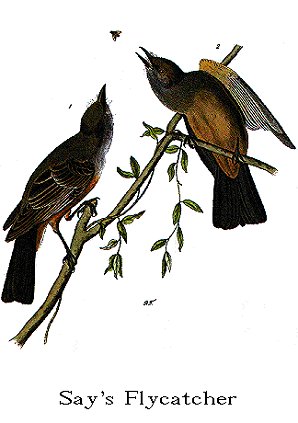
| Family VII. MUSCICAPINAE. FLYCATCHERS. GENUS II. MUSCICAPA, Linn. FLYCATCHER. |
Next >> |

Family |
SAY'S FLYCATCHER. [Say's Phoebe.] |
| Genus | MUSCICAPA SAYA, Bonap. [Sayornis saya.] |
This species was first discovered by TITIAN PEALE, Esq. of Philadelphia,
and named after Mr. THOMAS SAY by BONAPARTE, who described and figured it in his
continuation Of WILSON's American Ornithology. It appears to range over a very
extensive portion of country, lying between Mexico and the settlements of the
British Fur Companies, a pair having been procured at Carlton House, as
mentioned by Dr. RICHARDSON. Little is yet known of the habits of this species,
but it would seem, from Mr. NUTTALL'S remarks, to be a rupestrine Flycatcher,
and not strictly arboreal, as supposed by Mr. SWAINSON.
"We first observed this bird," says Mr. NUTTALL, "in our route westward,
about the 14th of June, within the first range of the Rocky Mountains called the
Black Hills, and in the vicinity of that northern branch of the Platte known by
the name of Larimie's Fork. At the time, we saw a pair perched as usual on
masses of rocks, from which, like the Pewee, though occasionally alighted, they
flew after passing insects, without uttering any note that we heard; and from
their predilection, it is probable they inhabit among broken bills and barren
rocks, where we have scarcely a doubt, from their behaviour, they had at this
time a brood in a nest among these granite cliffs. They appeared very timorous
on our approach, and seemed very limited in their range. Except among the Blue
Mountains of the Columbia, we scarcely ever saw them again. Their manners
appear to be very much like those of the Common Pewee; but they are much more
silent and shy."
SAY'S FLYCATCHER, Muscicapa Saya, Bonap. Amer. Orn., vol. i. p. 20.
MUSCICAPA SAYA, Bonap. Syn., p. 67.
TYRANNULA SAYA, Swains. and Rich. F. Bor. Amer., vol. ii. p. 142.
SAY'S FLYCATCHER, Muscicapa Saya, Nutt. Man., vol. i. p. 277.
SAY'S FLYCATCHER, Muscicapa Saya, Aud. Orn. Biog., vol. iv. p. 428.
Third quill longest, second and fourth scarcely shorter, first a little
longer than sixth; tail very slightly emarginate; upper parts greyish-brown;
upper tail-coverts and tail brownish-black; wings of a darker tint than the
back, the feathers margined with brownish-white; a dusky spot before the eye;
fore part and sides of neck light greyish-brown, shaded with pale brownish-red
on the breast and abdomen; lower wing-coverts reddish-white.
Male, 7, wing 4 2/12
Arkansas. Columbia river. Fur Countries. Never seen along the Atlantic.
Abundant. Migratory.
| Next >> |